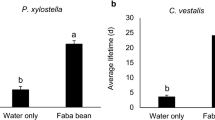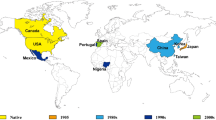Abstract
We studied the relationship between variation in age and shoot characteristics of the host plant Salix exigua Nuttall (coyote or sandbar willow) and the attack and survival of Euura sp. (an unnamed leaf-midrib galling sawfly). Variation in shoot characteristics resulted from reduced growth as willow ramets aged. Mean shoot length per ramet and mean longest leaf length per shoot decreased by 95% and 50% respectively between 1- and 9-year-old willow ramets. All measured shoot characteristics-shoot length, longest leaf length, number of leaves per shoot, and mean internode length-were significantly negatively correlated with ramet age (r 2 ranged from −0.23 to −0.41). Correlations between shoot characteristics were highly positive, indicating that plants also grew in a strongly integrated fashion (r 2 ranged from 0.54 to 0.85). Four hypotheses were examined to explain sawfly attack patterns. The host-plant hypothesis was supported in explaining enhanced larval sawfly survival through reduced plant resistance. As willow ramets aged, the probability of Euura sp. attack decreased over 10-fold, from 0.315 on 1-year-old ramets to 0.024 on 2- to 9-year-old ramets. As shoot length increased, the probability of sawfly attack increased over 100-fold, from 0.007 on shoots <100 mm, to 0.800 on shoots in the 1001–1100 mm shoot length class. These attack patterns occurred even though 1-year-old ramets and shoots >500 mm each represented less than 2% of the total shoots available for oviposition. Host plant induced mortality of the egg/early instar stage decreased by 50% on longer leaves and was the most important factor determining survival differences between vigorous and non-vigorous hosts. Sawfly attack was not determined by the resource distribution hypothesis. Although shoots <200 mm contained 82% of the total leaves available, they contained only 43% of the galls initiated. The attack pattern also was not explained by the gall volume hypothesis. Although gall volume increased on longer shoots, there was no significant variation in mid or late instar mortality over shoot length, as would be expected if food resources within smaller galls were limited. The natural enemy attack hypothesis could not explain the pattern of oviposition since predation was greater on longer shoots and leaves. In addition, larval survival was related to oviposition behavior. Due to a 69% reduction in late instar death and an 83% reduction in parasitism, survival of progeny in galls initiated close to the petiole base was 2.8 times greater than in galls initiated near the leaf tip. A 75% reduction in gall volume over this range of gall positions may account for the observed increases in late instar mortality and parasitism.
Similar content being viewed by others
References
Craig TP, Price PW, Itami JK (1986) Resource regulation by a stem-galling sawfly on the arroyo willow. Ecology 67:419–425
Craig TP, Price PW, Itami JK (1989) A strong relationship between oviposition preference and larval performance in a shoot-galling sawfly. Ecology 70:1691–1699
Dorn RD (1977) Willows of the Rocky Mountain states. Rhodora 79:390–429
Hunter MD, Price PW (1992) Playing chutes and ladders: heterogeneity and the relative roles of bottom-up and top-down forces in natural communities. Ecology 73:724–732
Jaenike J (1978) On optimal oviposition behavior in phytophagous insects. Theor Popul Biol 14:350–356
Kearsley MJC, Whitham TG (1989) Developmental changes in resistance to herbivory: Implications for individuals and populations. Ecology 70:422–434
Kolehmainen J, Roininen H, Julkunen-Tiitto R, Tahvanainen J (1994) Importance of phenolic glucosides in host selection of shoot galling sawfly, Euura amerinae, on Salix pentandra. J Chem Ecol 20:2455–2466
Larson KC, Whitham TG (1991) Manipulation of food resources by a gall-forming aphid: the physiology of sink-source interactions. Oecologia 88:15–21
Nothnagle PJ, Schultz JC (1987) What is a forest pest? In: Barbosa P, Schultz JC (eds), Insect outbreaks. Academic Press, San Diego, pp 59–79
Papaj DR, Rausher MD (1987) Components of conspecific host discrimination behavior in the butterfly Battus philenor. Ecology 68:245–253
Preszler RW, Price PW (1988) The effects of variable host quality on sawfly populations: a new approach to life table analysis. Ecology 69:2012–2021
Price PW (1989) Clonal development of coyote willow, Salix exigua (Salicaceae), and attack by the shoot-galling sawfly, Euura exigua (Hymenoptera: Tenthredinidae). Environ Entomol 18:61–68
Price PW (1990) Insect herbivore population dynamics: is a new paradigm available? Symp Biol Hung 39:177–190
Price PW (1991) The plant vigor hypothesis and herbivore attack. Oikos 62:244–251
Price PW (1994) Phylogenetic constraints, adaptive syndromes, and emergent properties: from individuals to population dynamics. Res Popul Ecol 36:3–14
Price PW, Clancy KM (1986) Interactions among three trophic levels: Gall size and parasitoid attack. Ecology 67:1593–1600
Price PW, Roininen H, Tahvanainen J (1987a) Plant age and attack by the bud galler, Euura mucronata. Oecologia 73:334–337
Price PW, Roininen H, Tahvanainen J (1987b) Why does the budgalling sawfly, Euura mucronata, attack long shoots? Oecologia 74: 1–6
Price PW, Cobb N, Craig T, Fernandes W, Itami J, Mopper S, Preszler R (1990) Insect herbivore population dynamics on trees and shrubs: new approaches relevant to latent and eruptive species. In: Bernays EA (ed), Insect-plant interactions, vol 2. CRC, Boca Raton, pp 1–38
Price PW, Craig TP, Roininen H (1995) Working toward theory on galling sawfly population dynamics. In: Cappuccino N, Price PW (eds) Population dynamics: new approaches and synthesis Academic Press, San Diego, pp 321–338
Price PW, Roininen H, Tahvanainen J (1996) Willow tree shoot module length and the attack and survival pattern of a shootgalling sawfly, Euura atra L. (Hymenoptera: Tenthredinidae). Entomol Fenn, in press
Rausher, MD (1983) Ecology of host-selection behaviour in phytophagous insects. In: Denno RF, McClure MS (eds) Variable plants and herbivores in natural and managed systems. Academic Press. New York, pp 223–257
Roininen H, Price PW, Tahvanainen J (1993) Colonization and extinction in a population of the shoot-galling sawfly, Euura amerinae. Oikos 68:448–454
Smith EL (1970) Biosystematics and morphology of Symphyta. II. Biology of gall-making nematine sawflies in the California region. Ann Entomol Soc Am 63:36–51
Stevens LE, Waring GL (1985) Effects of prolonged flooding on riparian vegetation in Grand Canyon. In: Johnson RR (ed) Riparian ecosystems and their management:reconciling management conflicts (general technical report RM-120). U.S. Forest Service, Fort Collins, pp 81–86
Waring GL, Price PW (1988) Consequences of host plant chemical and physical variability to an associated herbivore. Ecol Res 3:205–216
White TCR (1969) An index to measure weather-induced stress of trees associated with outbreaks of psyllids in Australia. Ecology 50:905–909
White TCR (1976) A hypothesis to explain outbreaks of looper caterpillars, with special reference to populations of Selidosema suavis in a plantation of Pinus radiata in New Zealand. Oecologia 16:279–301
White TCR (1978) Weather, food and plagues of locusts. Oecologia 22:119–134
Whitham TG (1979) Habitat selection by Pemphigus aphids in response to resource limitation and competition. Ecology 59: 1164–1176
Whitham TG (1979) Territorial behavior of Pemphigus gall aphids. Nature 279:324–325
Whitham TG (1980) The theory of habitat selection: examined and extended using Pemphigus aphids. Am Nat 115:449–466
Author information
Authors and Affiliations
Rights and permissions
About this article
Cite this article
Woods, J.O., Carr, T.G., Price, P.W. et al. Growth of coyote willow and the attack and survival of a mid-rib galling sawfly, Euura sp.. Oecologia 108, 714–722 (1996). https://doi.org/10.1007/BF00329047
Received:
Accepted:
Issue Date:
DOI: https://doi.org/10.1007/BF00329047




